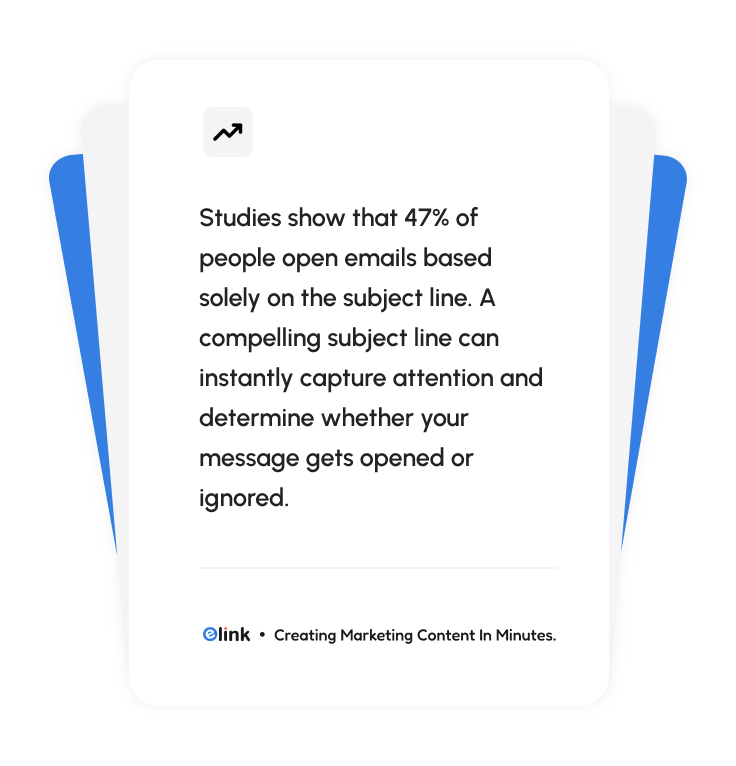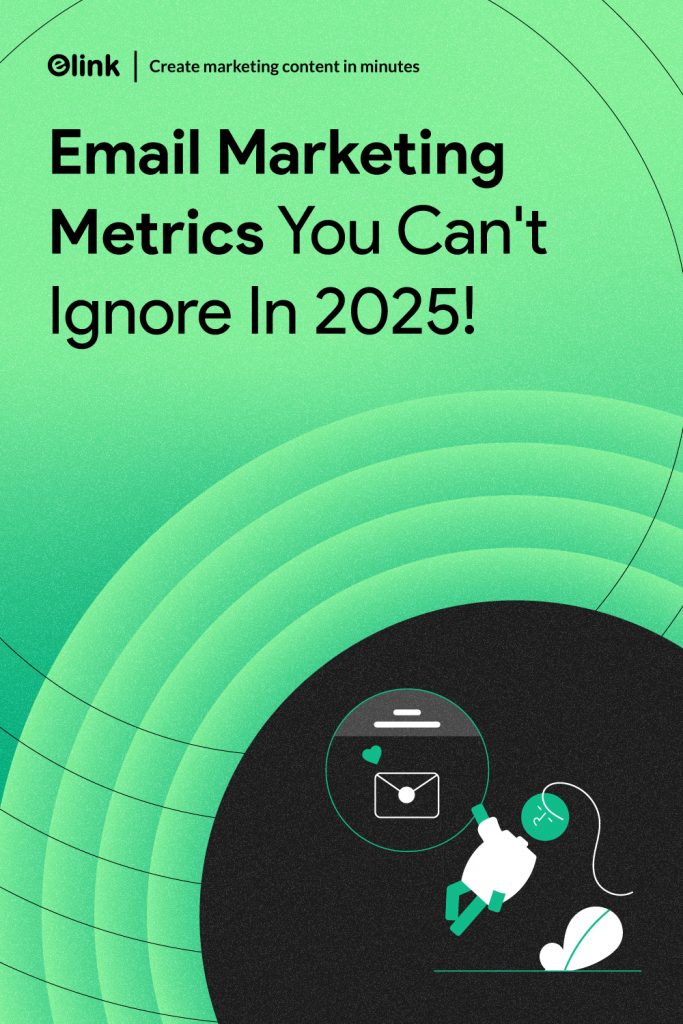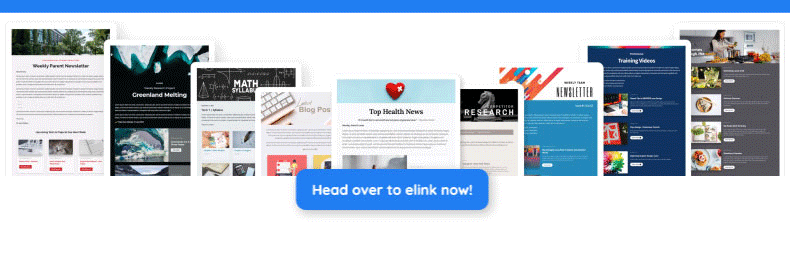Email marketing has truly come a long way. Years ago, it was just about sending out the same message to everyone on your email list with no personalization, no automation, and hardly any strategy. Also, there is no way to know how well your emails were performing, other than an occasional response.
But in 2025, email marketing has completely changed. Today, email marketing is a powerful tool with AI, automation, and real-time analytics that deliver the right message to the right person at the right moment.
But with all advancements in technology, simply sending the emails isn’t enough—you also need to track how your email campaigns are performing. And that’s where email metrics come in. Email metrics involve the number and data that help you determine whether your audience is reading your emails, clicking, responding, or ignoring your communications.
In this blog, we’ll explore the most important email marketing metrics to check in 2025 so you can leverage them to craft email marketing campaigns that drive real results. Ready to explore? Let’s get started with the basics of email marketing metrics.
Also Read 📚 AI in Email Marketing: How To Use it, The Benefits & Challenges!
What Exactly are Email Marketing Metrics?
You can begin by thinking of email marketing metrics like the report card for your email marketing campaigns. The email metrics tell you how well your emails are performing — are people opening and reading them, clicking on links, or ignoring them?
In short, metrics allow you to know what’s going well and what isn’t in your emails.
For instance, if you mail a newsletter and hardly anyone opens it, that’s an indication that something needs to change. On the other hand, if many people click on a link within your email, that indicates the content was engaging or useful.
So, in simple terms, email marketing metrics are figures or statistics that indicate how your readers are engaging with your emails. The metrics help you in improving your emails so that you can connect effectively with your subscribers, receive more clicks, and even generate more sales.
Here, we’ll be covering the most important email marketing metrics you must track, so you can stop guessing over the results and begin sending emails that actually work!
Bonus 🚀 Transform your email insights into visually appealing newsletters with elink.io
Email Marketing Metrics that You Must Know
Email metrics show you what’s working, what isn’t, and where you can improve your email campaigns for better results. By tracking these numbers, you can make better decisions and improve the results of your newsletters.
Here are the main email metrics to focus on:
- Open Rate
- Click-Through Rate (CTR)
- Bounce Rate
- Unsubscribe Rate
- Conversion Rate
- Spam Complaint Rate
- List Growth Rate
So, let’s get started with each of them one by one.
1. Open Rate – Are People Opening Your Emails?
Basically, the Open rate indicates how many people have actually opened your email. It is the most important step, as if no one opens your email, they won’t be able to see what’s inside, no matter how awesome the content is.
Why it matters: The first thing people notice in their received emails is their subject line. And if the subject line wasn’t interesting enough, they do not even feel the need to open it. In fact, studies show that 47% of people who decide to open an email do so because of the subject line only.

So when you check your open rate, you’re really measuring two things:
- How engaging your subject lines are
- Whether people are genuinely interested in your updates
A strong open rate means your subscribers trust you enough to click and find out more. Think of it as your audience raising their hand to say, “Yes, I want to hear from you.”
Must Check These 👉 Improve Email Open Rates with these 11 Powerful Tips & Tricks!
2. Click-Through Rate (CTR) – Are They Clicking on Your Content?
Okay, so people are opening your emails — nice! But what next? CTR reveals to you how many of those people actually clicked on a link inside your email.
Why it matters: Opens rates show interest, but clicks show intent in your content. A healthy CTR means your message resonated with the audience, your links were clear, and your call-to-action stood out.
📝 Quick Fact: According to recent studies, the average email click-through rate across industries is about 2.5% to 3%. This means if your CTR is higher than this, you’re doing a great job engaging your readers and driving action.
But if your CTR is low, it usually points to one of three things: your CTA (Call-to-action) isn’t strong enough, your links aren’t visible, or your content didn’t create enough curiosity to earn a click.
Think of CTR as your audience saying, “Yes, I’m interested. Show me more.” Click-through rates are one of the clearest signals that your email is moving people closer to the next step.
3. Bounce Rate – Did Your Emails Reach Anyone?
Bounce rate indicates the number of your emails that didn’t reach inboxes. In simple terms, it’s the percentage of emails that “bounced back” instead of being delivered.
There are two types of bounces:
- Soft bounces (temporary problems, such as full mailboxes), and
- Hard bounces (permanent issues, such as non-existent email addresses).
Why it matters: A high bounce rate is a warning sign. It’s often a sign that your email list is old or contains incorrect addresses. Too many bounces can damage your sender’s reputation, making it harder for future emails to land in inboxes.
👉 Industry data shows that a bounce rate over 2% is cause for concern, and the best-performing campaigns often keep their bounce rates below 1%.
So, keep your email list fresh. Regularly clean out invalid addresses and focus on quality subscribers. A healthy email list means better deliverability and a stronger chance your emails get seen.
Also Read ✨ Reduce Email Bounce Rates Using These 11 Tried & Tested Methods!
4. Unsubscribe Rate – Are People Losing Interest?
Your unsubscribe rate tells you how many people chose to stop receiving your emails after opening one. It’s a simple but important signal of audience interest in your content.
Why it matters: A few unsubscribes here and there are completely normal. But if lots of people are unsubscribing, it’s a warning sign. Maybe your subject lines are misleading, your emails feel too frequent, or the content just isn’t as relevant as subscribers expected.
But, instead of seeing unsubscribes as a bad thing, use them as feedback. Revisit your subject lines, tweak your email frequency, and make sure your content stays valuable and on-topic. The goal of email marketing isn’t just keeping people on your email list—it’s building a list of subscribers who genuinely want to hear from you.
5. Conversion Rate – Is Anyone Taking Action?
The conversion rate measures how many individuals not only just clicked your link in the email but also took an action, such as purchasing something, signing up for a webinar, or downloading a guide. This is one of the most important email marketing metrics, as the real success lies in it.
Why it matters: Every email is sent with some objective, whether it’s selling something or getting engagement on blogs. The conversion rate will let you know how good your email marketing strategy was at achieving your goals. So that you can take the necessary actions to improve the quality of your content.
Quick Insight💌 On average, email conversion rates hover around 1% to 5%. A higher conversion rate means your message, offer, and call-to-action are hitting the mark with your audience.
6. Spam Complaint Rate – Are You Annoying Your Subscribers?
Landing in the spam folder is every email marketer’s nightmare. Your spam complaint rate shows how many people marked your email as spam, and even a small number of complaints can hurt.
Why it matters: Even a few complaints can do damage to the sender’s reputation and future email deliverability. The email service provider may start sending your future emails to the spam folder. So, if people are marking your emails as spam, ask yourself:
- Are you sending too frequently?
- Are you emailing people who never opted in?
- Is your content truly relevant to what people signed up for your email?
The fix to spam complaints is very simple: always honor permissions, send at a reasonable frequency, and deliver the kind of content your audience expects when they join your newsletters. Respect your subscribers’ inboxes, and they’ll keep you out of the spam folder.
Know Your Mistakes 👉 8 Reasons Why Your Email Goes To Spam!
7. List Growth Rate – Is Your Email List Growing or Shrinking?
The growth rate of the email list measures how quickly your subscriber base is changing. It includes new sign-ups, unsubscribes, and even bounces to give you a clear picture of whether your list is expanding or shrinking.
Why it matters: A growing list means more people are interested in your content or brand. But a shrinking list is a red flag—it could mean your signup process isn’t appealing, your emails aren’t relevant enough, or you’re sending too often.
To keep your list healthy, make subscribing easy, deliver consistent value, and give people a good reason to join—and stay.
So, these email engagement metrics you need to know are like a playbook for your email program. Each one hints at what your readers like, what they dislike, and how to improve next time. The more closely you monitor these numbers, the smarter your email marketing will be, and the more effective your results will be.
Now, if you want to save time in designing the email, give elink.io a try. Creating high-converting newsletters just takes a few minutes with Elink. And if you send such gorgeous emails to your audience, the metrics get improved automatically. Want to know how? Let’s explore more about Elink.io.
Meet elink.io: Spend Less Time Building Emails, More Time Analyzing Results
If you want a simple yet powerful way to level up your email marketing, meet elink.io. It is the quickest way to create professional-looking emails, so you can spend less time designing and more time analyzing your email campaign results.
Elink.io is a smart content curation tool that helps you collect links, articles, videos, or products from anywhere on the web and instantly turn them into professional-looking newsletters, web pages, or even social media content.
Instead of spending hours on formatting and design, you can create eye-catching emails in minutes that your audience actually wants to open. When your emails are ready in minutes, you can focus more on the results—open rates, click-throughs, and engagement—so you can make smarter marketing decisions and get more done.
With elink.io, you don’t just send emails—you create experiences your audience looks forward to.
Here’s what you can do with Elink.io:
✔️ Create Newsletters in Minutes: You just need to paste the links of your content into Elink, and it will convert it into a sleek, ready-to-sendnewsletter created in minutes. The beautifully crafted newsletters can improve your email metrics.
✔️ Beautiful, Ready-Made Templates: Not a designer? No problem! Elink offers a wide range of modern, eye-catching templates that make your newsletters look professional and polished—no design experience needed.
✔️ Works Seamlessly with Your Favorite Tools: Whether you’re using Gmail, Outlook, or Mailchimp, Elink integrates with them all. So, you can create stunning newsletters in Elink and send them through your go-to platform—effortlessly.
✔️ Automate content with RSS feed: You simply have to connect your content to an RSS feed, and Elink will automatically update your webpages with your latest content. It saves time and keeps your audience always in the loop.
✔️ Stay Consistent (Without the Extra Work): With Elink, you cansave your favorite layouts, reuse content blocks, and update links as needed. Elink makes it easy for you to send regular newsletters—weekly, monthly, or whenever—with zero extra stress.
💥 Bonus: Here’s the cool part! Your curated content isn’t limited to just email inboxes. You can share it as a webpage, embed it on your site, or post it on LinkedIn, WhatsApp, or anywhere else. One creation, multiple uses!
Why People Love Elink for Email Marketing
- Elink is a very beginner-friendly tool
- You don’t need any coding or design skills
- It has over 100 integrated email providers, including Mailchimp and Gmail.
- It helps you in making professional emails that both look fantastic and deliver well
So, ready to bring a fresh, professional look to your emails? Try elink.io and see the difference it can make!
Conclusion: Let Your Metrics Guide the Way
So, email marketing in 2025 is about being strategic, smart, and customer-centric. It’s no longer simply a matter of hitting “send” and hoping for the best. You also need to know how your emails are performing.
All the email marketing metrics let you know what your audience loves, what they skip, and where you need to improve your strategy. Basically, metrics transform guesswork into clear direction, which can make a big difference in your emails.
Always monitor your metrics of the sent email, experiment with what works best for you, and always try to provide value with each email you send.
FAQs
Q1. What are the best email marketing KPIs?
Some best email marketing KPIs are:
- Open rate
- Click-through rate (CTR)
- Conversion rate
- Bounce rate
- Unsubscribe rate
These KPIs allow you to measure success and monitor whether your emails are achieving your goals or not such as increasing sales, signups, or engagement.
Q2. What counts as a good open rate?
A good open rate can vary by industry, but generally, it lies between 20% – 30%. If your open rate is lower than that, it might be time to improve your email marketing strategy, but if it’s higher, great job!
Q3. What’s the difference between open rate and deliverability?
Open rate tracks how many people actually opened your email, while deliverability, on the other hand, informs you if your email has reached the inbox or not.
So basically, Deliverability is reaching the inbox, and Open rate is what happens once it does.
Q4. How is click-through rate (CTR) calculated?
Click-through rate is calculated using the easy formula:
CTR = (Number of clicks ÷ Number of emails delivered) × 100
For instance, let’s say you delivered 1,000 emails and 50 individuals clicked on a link, your CTR would be:
(50 ÷ 1,000) × 100 = 5%
CTR indicates the number of people who were interested enough to click your links and learn more.






